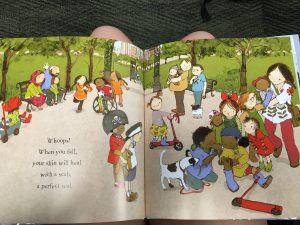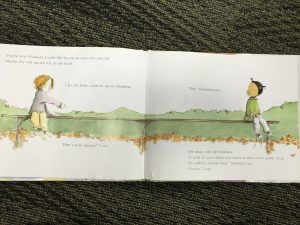Author: Angela Johnson
Illustrator/ Photographer: Beth Peck
Publisher and Year: Simon and Schuster Books for Young Readers, 2004
Number of Pages: 29 Pages
Genre: Historical Fiction
The story of this book is about an African American girl who wants to play baseball just like Josh Gibson, “the Babe Ruth of the Negros Leagues” (Johnson, 2004). Grandmama tells the story in flashbacks of her growing up loving baseball but never getting the chance (with the exception of one time) to play in a real game because she was a girl.
This text serves as a door, window, and mirror all at the same time. First, it serves as a window because the reader sees a story of a girl of color surpassing societal norms of the time and proving she can play baseball as well as the boys. This aspect of the story not only breaks racial stereotypes, but also gender stereotypes that girls cannot be as good as boys at sports. Second, it serves as a mirror to call upon the reader to reflect on how he/she handles stereotypes among different groups of people. Thirdly, it serves as a door to show that women have the opportunity to do the same sports and activities as men.
The entire tale of this story is Grandmama referring back to her childhood playing baseball. Jack Gibson was an African American baseball player that unfortunately never made it to the major leagues for baseball (Johnson 2004). With Grandmama already being a woman, an African American, and the setting of the flashback in the 1940s, Grandmama had no power. But, that did not stop Grandmama’s father from teaching her how to play baseball so that she could be just like Josh Gibson. Two cultures are noticeably identified and represented in this story: women and African Americans. As a woman, Grandmama was able to overcome barriers and show she was just as good as the boys in a male dominated activity, baseball.
At the same time, this book gives respect to the African American community by acknowledging their culture, contribution, and love for baseball as well. In regards to my understanding of culture, this story speaks and represents African Americans in a sport favored by America but also, it shows girls that they are not limited to anything simply for being a girl. Though the images take up most of pages, the words on the page are easy to find showing that the images and text are both important to the story as a whole. The characters of Josh Gibson and Grandmama (as a little girl) are looking to the right, symbolizing them both breaking gender and racial barriers and moving forward. The colors in the story are dull and faded possibly representing the whole flashback, and/or the disappearance of racial and gender stereotypes in sports. The dialect of Grandmama speaks represents her African American culture. The words and images mirror one another, showing a clear picture of the flashback Grandmama is trying to convey to her granddaughter (in the present time). The biggest ideologies of this storybook are girls can play with the boys, race does not make someone inferior or superior, and girls are not to be limited to things simply because they are girls.








 between both girls. As they continue to talk, the girls move closer together. In the story, the fence is a physical barrier between the interaction of the African American and the White populations. It also symbolically represents the barriers that people, especially African Americans, face in their lives. This title, The Other Side, also refers to another aspect of the story. This story features a main character that questions why racism and prejudice are ruling people’s lives. In this case, the character is the person on the other side of the powerful race during this time. This powerful theme carries into other aspects of life. Readers will benefit from the tolerance displayed in the story.
between both girls. As they continue to talk, the girls move closer together. In the story, the fence is a physical barrier between the interaction of the African American and the White populations. It also symbolically represents the barriers that people, especially African Americans, face in their lives. This title, The Other Side, also refers to another aspect of the story. This story features a main character that questions why racism and prejudice are ruling people’s lives. In this case, the character is the person on the other side of the powerful race during this time. This powerful theme carries into other aspects of life. Readers will benefit from the tolerance displayed in the story.
 and bright. The images often reinforce the ideas presented in the text, and sometimes act as an enhancement. They show the diversity in skin color and features as well as the physical abilities that are discussed in the text. This book allows for children to see that each person has the same physical feature, skin. It teaches them the importance of skin and how it helps our body. This allows for an easy opportunity for educators or parents to have discussions about race. It teaches the importance of tolerance and acceptance of others who may look different. The illustrations radiate the idea of acceptance, as we see children of all ethnicities and cultures interacting in public places.
and bright. The images often reinforce the ideas presented in the text, and sometimes act as an enhancement. They show the diversity in skin color and features as well as the physical abilities that are discussed in the text. This book allows for children to see that each person has the same physical feature, skin. It teaches them the importance of skin and how it helps our body. This allows for an easy opportunity for educators or parents to have discussions about race. It teaches the importance of tolerance and acceptance of others who may look different. The illustrations radiate the idea of acceptance, as we see children of all ethnicities and cultures interacting in public places.


 Perceptually, the images are very bright and enticing for the children. The use of faded watercolor pictures, such as in the picture below, allows the focus to remain on the narrator and James. The use of large text in certain areas allows the reader to recognize which points should be emphasized while reading the story aloud. Some of the illustrations resemble the ones that children would draw, making it very relatable for the readers. The layout of the text in relation to the pictures also allows the readers to follow the sequence very well, especially when the author is describing how each classmate heard the rumor about the narrator. Ideologically, this book shows the dangers of gossip and rumors and the effects they have on friendships. The misunderstanding during the “game of telephone” leads to the narrator’s feelings getting hurt by her best friend. Children who read this book are able to see the damage done by gossip and rumors. The ending of the book allows readers to see some things can be misunderstood and taken out of proportion. It also emphasizes the idea of friendship and its importance. The two sided story, the narrator and James’ actions, also show the different emotions when two friends are fighting. This book also gives an example of how children can solve problems with their friends. However, the way in which the narrator reacts is not recommended for children.
Perceptually, the images are very bright and enticing for the children. The use of faded watercolor pictures, such as in the picture below, allows the focus to remain on the narrator and James. The use of large text in certain areas allows the reader to recognize which points should be emphasized while reading the story aloud. Some of the illustrations resemble the ones that children would draw, making it very relatable for the readers. The layout of the text in relation to the pictures also allows the readers to follow the sequence very well, especially when the author is describing how each classmate heard the rumor about the narrator. Ideologically, this book shows the dangers of gossip and rumors and the effects they have on friendships. The misunderstanding during the “game of telephone” leads to the narrator’s feelings getting hurt by her best friend. Children who read this book are able to see the damage done by gossip and rumors. The ending of the book allows readers to see some things can be misunderstood and taken out of proportion. It also emphasizes the idea of friendship and its importance. The two sided story, the narrator and James’ actions, also show the different emotions when two friends are fighting. This book also gives an example of how children can solve problems with their friends. However, the way in which the narrator reacts is not recommended for children.![IMG_9616 [405973]](https://blogs.iwu.edu/lrbmt2016/files/2016/05/IMG_9616-405973-234x300.jpg)
![IMG_9617 [405974]](https://blogs.iwu.edu/lrbmt2016/files/2016/05/IMG_9617-405974-220x300.jpg)
![IMG_9620 [405977]](https://blogs.iwu.edu/lrbmt2016/files/2016/05/IMG_9620-405977-300x238.jpg)
![IMG_9621 [405978]](https://blogs.iwu.edu/lrbmt2016/files/2016/05/IMG_9621-405978-300x238.jpg)



